A Bibliometric Analysis of Service Quality in the Hospitality Industry (2014–2024)
Abstract
1. Introduction
2. Literature Review
2.1. Concept of Service Quality
2.2. Service Quality and the Hospitality Sector
2.3. Service Quality Model
- Reliability: Srivastava and Dubey (2024) noted that this aspect concerns the ability and reliability of a business entity for the provision of services capable of meeting the expectations of customers. Asgeirsson et al. (2024) noted that the capacity to provide dependable and accurate services reflects reliability. Mijatov et al. (2018) asserted that reliability is very important because it aids in building trust between the organizations that provide the services and the clients that are recipients of the services offered. Shameem and Pretha (2012) opined that reliability relates to the capacity of organizations to deliver the services that had been promised to customers, doing so with accuracy and dependability.
- Responsiveness: Ahmad et al. (2018) pointed out that the ability of the hospitality sector to promptly resolve complaints and render exceptionally rapid services to customers is termed responsiveness. Assistance rendered to clients and prompt delivery of services are underscored by the concept of responsiveness (Srivastava & Dubey, 2024).
- Tangibility: This dimension of service quality is defined by physical characteristics such as construction, machinery, communication equipment, and technology (Srivastava & Dubey, 2024). Asgeirsson et al. (2024) noted that tangibility encompasses all that can be seen, touched, or felt, ranging from solid structures through to equipment used for the provision of services and outfits of employees.
- Empathy: Srivastava and Dubey (2024) suggested that the mode with which a business entity renders services to ensure that the company appears empathetic to its clients’ needs is rooted in the concept of empathy. Shameem and Pretha (2012) stated that empathy encompasses easy access, being approachable, and various efforts to identify and meet guests’ demands and expectations.
- Assurance: Employees’ knowledge, courtesy, competence, and ability to instill trust and confidence in customers is collectively known as assurance. Shameem and Pretha (2012) opined that the competence with which the service is provided and it being credible, courteous, and secure ensure that such service provides assurance to the client.
3. Materials and Methods
- Q1:
- What was the citation overview of the publications in 2014–2024?
- Q2:
- What were the sources of the publications in 2014–2024?
- Q3:
- What was the information about the authors of publications in 2014–2024?
- Q4:
- What was the conceptual structure of the publications in 2014–2024?
- Q5:
- What was the social structure of the publications in 2014–2024?
4. Results
- Q1:
- What was the citation overview of the publications in 2014–2024?
- Q2:
- What were the sources of the publications in 2014–2024?
- Q3:
- What was the information about the authors of the publications in 2014–2024?
- Q4:
- What was the conceptual structure of the publications in 2014–2024?
- Q5:
- What was the social structure of the publications in 2014–2024?
5. Discussion
5.1. Citation Overview of the Publications in 2014–2024
5.2. Sources of the Publications in 2014–2024
5.3. Information About the Authors of the Publications in 2014–2024
5.4. Conceptual Structure of the Publications in 2014–2024
5.5. Social Structure of the Publications in 2014–2024
6. Conclusions
6.1. Practical Implications
6.2. Research Limitations
Author Contributions
Funding
Institutional Review Board Statement
Informed Consent Statement
Data Availability Statement
Conflicts of Interest
References
- Abdullah, N., & Othman, M. (2019). Effects of intellectual capital on the performance of Malaysian food and beverage small and medium-sized enterprises. International Journal of Civil Engineering and Technology, 10(2), 135–143. [Google Scholar]
- Abdullah, N., & Rahman, M. (2015). The use of deliberative democracy in public policy making process. Public Policy and Administration Research, 5(3), 221–229. [Google Scholar] [CrossRef]
- Abdullah, O., Sufi, T., & Kumar, S. (2022). Service quality and its influence on customer satisfaction and customer loyalty in the restaurants of five-star hotels. African Journal of Hospitality, Tourism and Leisure, 11, 2173–2189. [Google Scholar]
- Ahmad, S. Z., Ahmad, N., & Papastathopoulos, A. (2018). Measuring service quality and customer satisfaction of the small-and medium-sized hotels (SMSHs) industry: Lessons from United Arab Emirates (UAE). Tourism Review, 74(3), 349–370. [Google Scholar] [CrossRef]
- Ali, B., Gardi, B., Othman, B., Ahmed, S., Ismael, N., Hamza, P., Aziz, H., Sabir, B., Sorguli, S., & Anwar, G. (2021). Hotel service quality: The impact of service quality on customer satisfaction in hospitality. International Journal of Engineering, Business and Management, 5(3), 14–28. [Google Scholar] [CrossRef]
- Ali, J., Saleh, P., Akoi, S., Abdulrahman, A., Muhamed, S., Noori, N., & Anwar, G. (2021). Impact of service quality on the customer satisfaction: Case study at online meeting platforms. International Journal of Engineering, Business and Management, 5(2), 65–77. [Google Scholar] [CrossRef]
- Aminudin, N., Hassan, N., Shaukani, A., & Jamal, S. (2021). Customer satisfaction towards hotel Industry in Malaysia: A systematic review of pre-COVID19 era. Insight Journal, 8, 1–12. [Google Scholar]
- Anas, M. (2024). Customer satisfaction in the hotel industry: A case study from Makassar City. Journal of Economic and Entrepreneurship Studies, 5(2), 135–150. Available online: https://www.researchgate.net/publication/382369424_Customer_Satisfaction_in_the_Hotel_Industry_A_Case_Study_from_Makassar_City/fulltext/669a5d5c02e9686cd10dd8a5/Customer-Satisfaction-in-the-Hotel-Industry-A-Case-Study-from-Makassar-City.pdf (accessed on 23 April 2025). [CrossRef]
- Anwar, G., & Abdullah, N. (2021). Inspiring future entrepreneurs: The effect of experiential learning on the entrepreneurial intention at higher education. International Journal of English Literature and Social Sciences, 6, 183–194. [Google Scholar] [CrossRef]
- Arasli, H., Saydam, M. B., & Kilic, H. (2020). Cruise travelers’ service perceptions: A critical content analysis. Sustainability, 12(17), 6702. [Google Scholar] [CrossRef]
- Aria, M., & Cuccurullo, C. (2017). Bibliometrix: An R-tool for comprehensive science mapping analysis. Journal of Informetrics, 11(4), 959–975. [Google Scholar] [CrossRef]
- Asgeirsson, M., Gudlaugsson, T., & Jóhannesson, G. (2024). The relationships between service quality, reputation, and performance in hospitality. Tourism and Hospitality, 5, 736–752. [Google Scholar] [CrossRef]
- Blanco-Moreno, S., Aydemir-Dev, M., Santos, C., & Bayram-Arli, N. (2025). Emerging sustainability themes in the hospitality sector: A bibliometric analysis. European Research on Management and Business Economics, 31, 100272. [Google Scholar] [CrossRef]
- Blanco-Moreno, S., González-Fernández, A. M., & Muñoz-Gallego, P. A. (2023). Big data in tourism marketing: Past research and future opportunities. Spanish Journal of Marketing—ESIC, 28(3), 266–286. [Google Scholar] [CrossRef]
- Blesic, I., Tesanovic, D., & Psodorov, D. (2011). Consumer satisfaction and quality management in the hospitality industry in South-East Europe. African Journal of Business Management, 5(4), 1388–1396. [Google Scholar]
- Boora, S., & Dhankar, S. (2017). Foreign direct investment and its impact upon the Indian hospitality industry. African Journal of Hospitality, Tourism and Leisure, 6(1), 1–17. [Google Scholar]
- Bore, I., Rutherford, C., Glasgow, S., Taheri, B., & Antony, J. (2017). A systematic literature review on eWOM in the hotel industry: Current trends and suggestions for future research. Hospitality and Society, 7(1), 63–85. [Google Scholar] [CrossRef]
- Chatterjee, P. (2022). Chapter 8—Trends and challenges in hospitality management. In Research trends in management (pp. 1–14). AkiNik Publications. [Google Scholar] [CrossRef]
- Chen, F., & Chen, F. (2010). Experience quality, perceived value, satisfaction and behavioural intentions for heritage tourists. Tourism Management, 31(1), 29–35. [Google Scholar] [CrossRef]
- Chen, J. (2011). Innovation in hotel services: Culture and personality. International Journal of Hospitality Management, 30(1), 64–72. [Google Scholar] [CrossRef]
- Chikazhe, L., Makanyeza, C., & Chigunhah, B. (2021). Understanding mediators and moderators of the effect of customer satisfaction on loyalty. Cogent Business and Management, 8(1), 1–9. [Google Scholar] [CrossRef]
- Cobo, J., Lopez-Herrera, G., Herrera-Viedma, E., & Herrera, F. (2012). SciMAT: A new science mapping analysis software tool. Journal of the American Society for Information Science and Technology, 3(8), 1609–1630. [Google Scholar] [CrossRef]
- Dörtyol, I. T., Varinli, I., & Kitapci, O. (2014). How do international tourists perceive hotel quality? An exploratory study of service quality in Antalya tourism region. International Journal of Contemporary Hospitality Management, 26(3), 470–495. [Google Scholar] [CrossRef]
- Firdaus, A., Razak, M. F. A., Feizollah, A., Hashem, T., Hazim, M., & Anuar, N. (2019). The rise of “blockchain”: Bibliometric analysis of blockchain study. Scientometrics, 120, 1289–1331. [Google Scholar] [CrossRef]
- Getty, J., & Getty, R. (2003). Lodging quality index (LQI): Assessing customers’ perceptions of quality delivery. International Journal of Contemporary Hospitality Manaagement, 15, 94–104. [Google Scholar] [CrossRef]
- González-Rodríguez, R., Martínez-Torres, R., & Toral, S. (2016). Post-visit and pre-visit tourist destination image through eWOM sentiment analysis and perceived helpfulness. International Journal of Contemporary Hospitality Manaagement, 28, 2609–2627. [Google Scholar] [CrossRef]
- Hu, F., Teichert, T., Liu, Y., Li, H., & Gundyreva, E. (2019). Evolving customer expectations of hospitality services: Differences in attribute effects on satisfaction and Re-Patronage. Tourism Management, 74(2019), 345–357. [Google Scholar] [CrossRef]
- Jou, R., & Day, J. (2021). Application of revised importance-performance analysis to investigate critical service quality of hotel online booking. Sustainability, 13, 2043. [Google Scholar] [CrossRef]
- Kalnaovakul, K., Balasubramanian, K., & Chuah, S. (2024). Service quality, customer sentiment and online ratings of beach hotels: An analysis of moderating factors. Journal of Hospitality and Tourism Insights, 8(3), 988–1009. [Google Scholar] [CrossRef]
- Kourie, H., Eid, R., & Haddad, F. (2020). The future of cancer research after COVID-19 pandemic: Recession? Future Oncology, 16, 1493–1495. [Google Scholar] [CrossRef]
- Legendre, T., Ding, A., & Back, K. (2024). A bibliometric analysis of the hospitality and tourism environmental, social, and governance (ESG) literature. Journal of Hospitality and Tourism Management, 58(2024), 309–321. [Google Scholar] [CrossRef]
- Light, P., Polley, E., & Borner, K. (2014). Open data and open code for big science of science studies. Scientometrics, 101(2), 1535–1551. [Google Scholar] [CrossRef]
- Linnenluecke, K., Marrone, M., & Singh, K. (2019). Conducting systematic literature reviews and bibliometric analyses. Australian Journal of Management, 45(2), 175–194. [Google Scholar] [CrossRef]
- Luk, K., & Layton, R. (2004). Managing both outcome and process quality is critical to quality of hotel service. Total Quality Management & Business Excellence, 15(3), 259–278. [Google Scholar]
- Luo, Z., & Qu, H. (2016). Guest-defined hotel service quality and its impacts on guest loyalty. Journal of Quality Assurance in Hospitality and Tourism, 17(3), 311–332. [Google Scholar] [CrossRef]
- Makoondlall-Chadee, T., & Bokhoree, C. (2024). Environmental sustainability in hotels: A review of the relevance and contributions of assessment tools and techniques. Administrative Sciences, 14(12), 320. [Google Scholar] [CrossRef]
- Mehmood, W., Ahmad, A., Aman-Ullah, A., & Mohd-Rashid, R. (2022). Modern slavery: A literature review using bibliometric analysis and the nexus of governance. Journal of Public Affairs, 23(1), e2832. [Google Scholar] [CrossRef]
- Mijatov, M., Blešić, I., & Dragin, A. (2018). Corporate social responsibility and service orientation of hotel employees. Teme, 42, 441–458. [Google Scholar]
- Naldi, S., Maulina, E., Herawaty, T., & Irawati, R. (2022). Hospitality and tourisminnovation: A systematic literature review. Bisnis dan Manajemen BISMA, 14(2), 94–109. [Google Scholar] [CrossRef]
- Olawuyi, O. S., & Babawale, M. O. (2024). Tourists’ perception of theme park as a driver of sustainable development: The case of Shoprite Theme Park in Ibadan. African Journal of Hospitality and Tourism Management, 4(2), 33–51. [Google Scholar] [CrossRef]
- Olawuyi, O. S., Balogun, B. K., & Macaulay, B. (2024). Service quality of hotels as a driver of beach tourism: Landmark Hotel, Lagos State, Nigeria. Amity Journal of Management, 12(1), 31–38. Available online: https://www.amity.edu/gwalior/ajm/pdf/ajm_june_2024_paper_3.pdf (accessed on 13 March 2025).
- Oliveras-Villanueva, M., Llach, J., & Perramon, J. (2020). Service quality in hospitality and the sustainability effect: Systematic literature review and future research agenda. Sustainability, 12(19), 8152. [Google Scholar] [CrossRef]
- Olowoyo, M., Ramaila, S., & Mavuru, L. (2021). Challenges and growth trajectory of the hospitality industry in South Africa (1994–2020). African Journal of Hospitality, Tourism and Leisure, 10(3), 1077–1091. [Google Scholar] [CrossRef]
- Othman, J., Al-Kake, F., Diah, M., Othman, B., Hussein, S., & Hasan, M. (2019). Impact of the foreign direct investment on the economy of the United Kingdom. International Journal of Psychosocial Rehabilitation, 23(02), 743–763. [Google Scholar]
- Parasuraman, A., Zeithaml, V., & Berry, L. (1985). A conceptual model of service quality and its implications for future research. Journal of Marketing, 49(4), 41–50. [Google Scholar] [CrossRef]
- Perdomo-Verdecia, V., Garrido-Vega, P., & Sacristan-Díaz, M. (2024). An fsQCA analysis of service quality for hotel customer satisfaction. International Journal of Hospitality Management, 122, 103793. [Google Scholar] [CrossRef]
- Persson, O., Danell, R., & Schneider, J. (2009). How to use bibexcel for various types of bibliometric analysis (pp. 9–24). Available online: https://www.researchgate.net/publication/285473885_How_to_use_Bibexcel_for_various_types_of_bibliometric_analysis (accessed on 23 April 2025).
- Pilelienė, L., Grigaliūnaitė, V., & Bogoyavlenska, Y. (2024). A bibliometric review of innovations in sustainable tourism research: Current trends and future research agenda. Sustainability, 16(16), 7124. [Google Scholar] [CrossRef]
- Prabhu, M., Nambirajan, T., & Abdullah, N. (2020). Operating competitive priorities of manufacturing firms: An analytical study. Journal of Industrial Engineering and Management, 13(1), 38–55. [Google Scholar]
- Rahman, A., Björk, P., & Ravald, A. (2020). Exploring the effects of service provider’s organizational support and empowerment on employee engagement and wellbeing. Cogent Business and Management, 7(1), 1767329. [Google Scholar] [CrossRef]
- Rajeswari, S., Srinivasulu, Y., & Thiyagarajan, S. (2017). Relationship among service quality, customer satisfaction and customer loyalty: With special reference to wireline telecom sector (DSL service). Global Business Review, 18(4), 1041–1058. [Google Scholar] [CrossRef]
- Raynaud, M., Goutaudier, V., Louis, K., Al-Awadhi, S., Dubourg, Q., Truchot, A., Brousse, R., Saleh, N., Giarraputo, A., Debiais, C., Demir, Z., Certair, A., Tacafred, F., Cortes-Garcia, E., Yanes, S., Dagobert, J., Naser, S., Robin, B., Loupy, A., … Jouven, X. (2021). Impact of the COVID-19 pandemic on publication dynamics and non-COVID-19 research production. BMC Medical Research Methodology, 21, 255. [Google Scholar] [CrossRef]
- Rhou, Y., & Singal, M. (2020). A review of the business case for CSR in the hospitality industry. International Journal of Hospitality Management, 84, 102330. [Google Scholar] [CrossRef]
- Santos, L., Cardoso, L., Araújo-Vila, N., & Fraiz-Brea, J. A. (2020). Sustainability perceptions in tourism and hospitality: A mixed-method bibliometric approach. Sustainability, 12(21), 8852. [Google Scholar] [CrossRef]
- Saputra, A., & Djumarno, D. (2021). Effect of price and service quality on customer satisfaction and its implications for customer loyalty at Aston Pluit Hotel, Residence Jakarta. Dinasti International Journal of Economics, Finance, Accounting, 2, 71–84. [Google Scholar] [CrossRef]
- Shafiq, A., Mostafiz, I., & Taniguchi, M. (2019). Using SERVQUAL to determine Generation Y’s satisfaction towards hoteling industry in Malaysia. Journal of Tourism Futures, 5(1), 62–74. [Google Scholar] [CrossRef]
- Shah, U., Jan, S., & Baloch, Q. (2018). Role of service quality and customer satisfaction in firm’s performance: Evidence from Pakistan Hotel Industry. Pakistan Journal of Commerce & Social Sciences, 12, 167–182. [Google Scholar]
- Shameem, A., & Pretha, S. (2012). A study of service quality in the hospitality industry. Research Journal of Commerce and Behavioural Science, 1(6), 22–28. [Google Scholar]
- Sharma, V., & Bhat, D. (2022). Co-creation and technological innovation: The predictors of guest satisfaction and revisit intention in hospitality industry. International Journal of Hospitality and Tourism Systems, 15(1), 91–100. [Google Scholar]
- Shyju, P. J., Singh, K., Kokkranikal, J., Bharadwaj, R., Rai, S., & Antony, J. (2021). Service quality and customer satisfaction in hospitality, leisure, sport and tourism: An assessment of research in Web of Science. Journal of Quality Assurance in Hospitality & Tourism, 24, 24–50. [Google Scholar] [CrossRef]
- Sigala, M., Kumar, S., Donthu, N., & Joshi, Y. (2021). A bibliometric overview of the journal of hospitality and tourism management: Research contributions and influence. Journal of Hospitality and Tourism Management, 47(5), 273–288. [Google Scholar] [CrossRef]
- Singh, R., & Nika, A. (2019). Influence of service quality on brand image and repeat patronage in hospitality industry: A content analysis. African Journal of Hospitality, Tourism and Leisure, 8(3), 1–19. Available online: https://www.ajhtl.com/uploads/7/1/6/3/7163688/article_42_vol_8_3__2019.pdf (accessed on 16 April 2025).
- Song, Y., Liu, K., Guo, L., Yang, Z., & Jin, M. (2022). Does hotel customer satisfaction change during the COVID-19? A perspective from online reviews. Journal of Hospitality and Tourism Management, 51, 132–138. [Google Scholar] [CrossRef]
- Srivastava, S., & Dubey, A. (2024). Impact of service quality on customer satisfaction: An empirical study with Indian hospitality industry. African Journal of Biological Sciences, 6(12), 13–18. Available online: https://www.afjbs.com/uploads/paper/e9ea9fb4afb840d5da23ad0612ae1017.pdf (accessed on 15 April 2025).
- Subying, C., & Yoopetch, C. (2023). A bibliometric review of revenue management in the tourism and hospitality industry, 1989–2021. Sustainability, 15, 15089. [Google Scholar] [CrossRef]
- Sweileh, W. (2020). Bibliometric analysis of peer-reviewed literature on climate change and human health with an emphasis on infectious diseases. Globalization and Health, 16(1), 44. [Google Scholar] [CrossRef]
- Top, C., & Ali, B. (2021). Customer satisfaction in online meeting platforms: Impact of efficiency, fulfillment, system availability, and privacy. Amazonia Investiga, 10(38), 70–81. [Google Scholar] [CrossRef]
- Uddin, S., Khan, A., & Lu, H. (2023). Impact of COVID-19 on journal impact factor. Journal of Informetrics, 17, 101458. [Google Scholar] [CrossRef]
- Uslu-Cibere, G., Basaran, M. A., & Kantarci, K. (2020). Evaluation of hotel performance attributes through consumer generated reviews: The case of bratislava1. Advanaces in Hospitality and Tourism Research, 8, 48–75. [Google Scholar] [CrossRef]
- Van Eck, N. J., & Waltman, L. (2014). CitNetExplorer: A new software tool for analysing and visualising citation networks. Journal of Informetrics, 8(4), 802–823. [Google Scholar] [CrossRef]
- Victorino, L., Verma, R., Plaschka, G., & Dev, C. (2005). Service innovation and customer choices in the hospitality industry. Managing Service Quality: An International Journal, 15(6), 555–576. [Google Scholar] [CrossRef]
- Wang, J., & Wang, J. (2009). Issues, challenges, and trends, that facing hospitality industry. Management Science and Engineering, 3(4), 53–58. Available online: https://core.ac.uk/download/pdf/236302656.pdf (accessed on 27 March 2025).
- Wilson, A., Zeithaml, V., Bitner, M., & Gremler, D. (2021). Services marketing: Integrating customer service across the firm (4th ed.). McGraw-Hill Education. [Google Scholar]
- Woratschek, H., Horbel, C., & Popp, B. (2020). Determining customer satisfaction and loyalty from a value co-creation perspective. The Service Industries Journal, 40(11), 777–799. [Google Scholar] [CrossRef]
- Zeithaml, A., Bitner, J., Gremler, D., & Mende, M. (2024). Services marketing integrating customer focus across the firm (8th ed.). McGraw Hill. [Google Scholar]
- Zeithaml, V. (2000). Service quality, profitability, and the economic worth of customers: What we know and what we need to learn. Journal of the Academy of Marketing Science, 28, 67–85. [Google Scholar] [CrossRef]
- Zhang, C., Moreira, A., & Sousa, A. (2020). A bibliometric view on the use of total quality management in services. Total Quality Management and Business Excellence, 32, 1466–1493. [Google Scholar] [CrossRef]
- Zulfiqar, U., Abbas, A., Aman-Ullah, A., & Mehmood, W. (2024). A bibliometric and visual analysis of revisit intention research in hospitality and tourism. Journal of Tourism Futures, 9, e13487. [Google Scholar] [CrossRef]
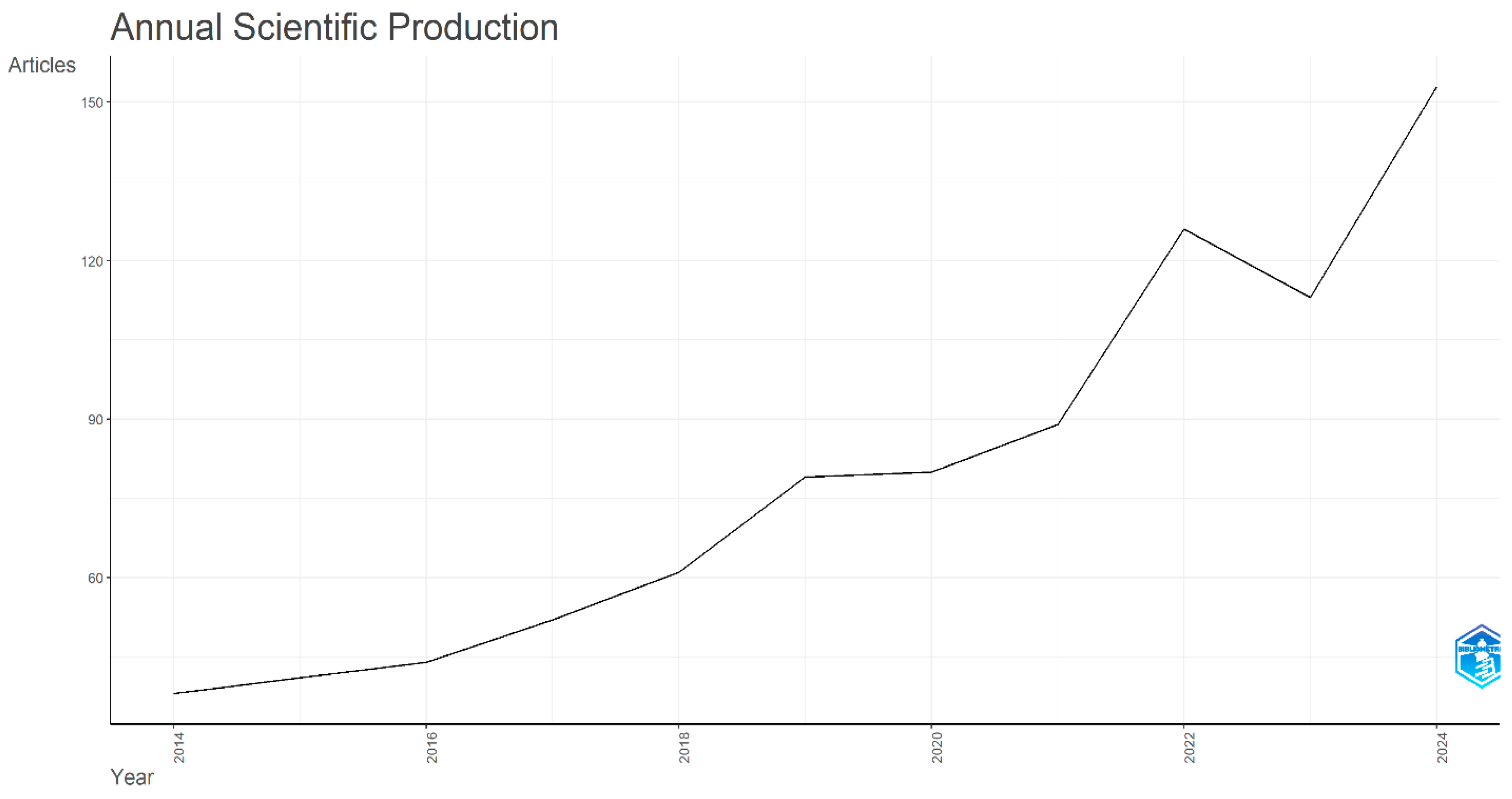
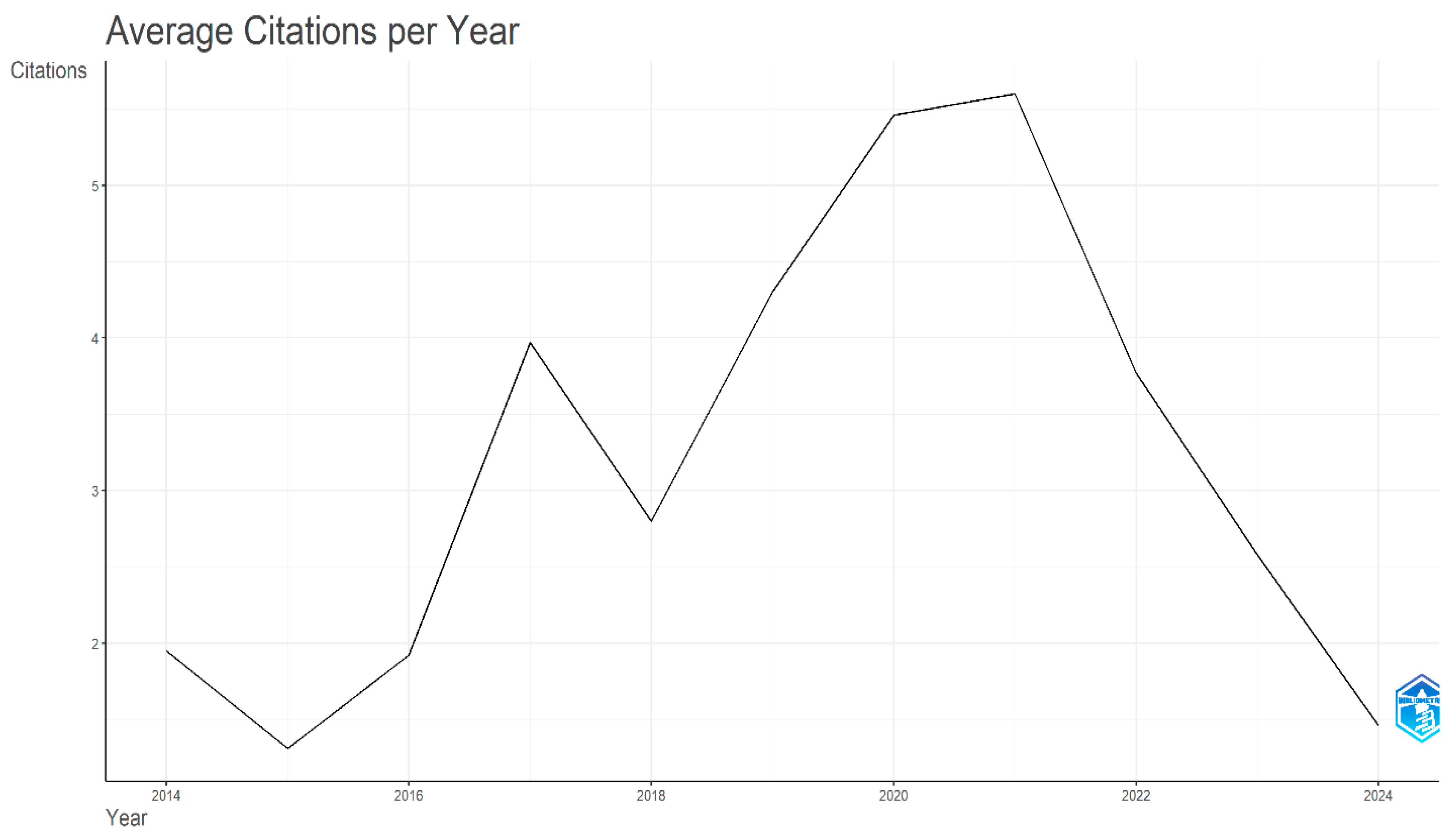
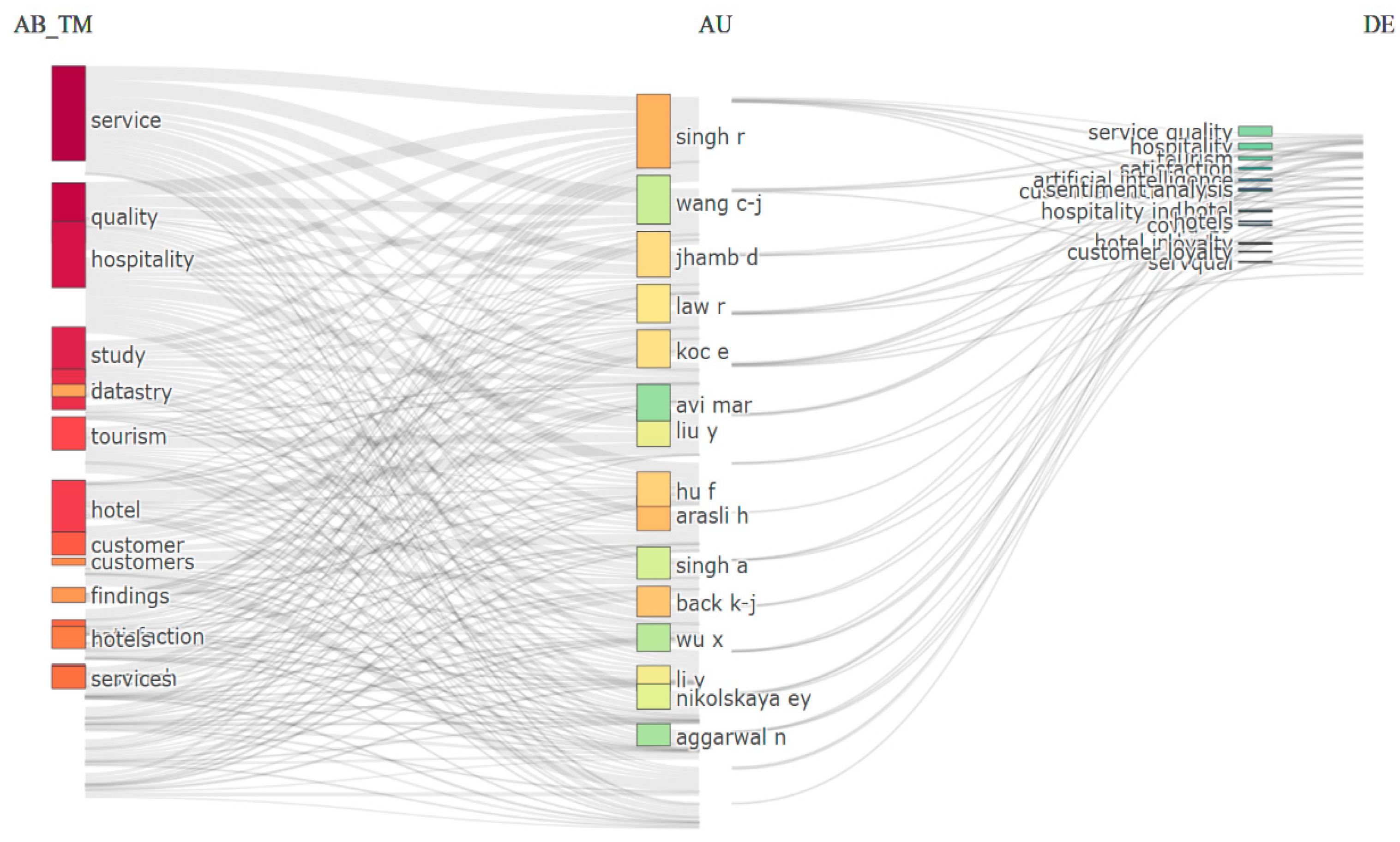

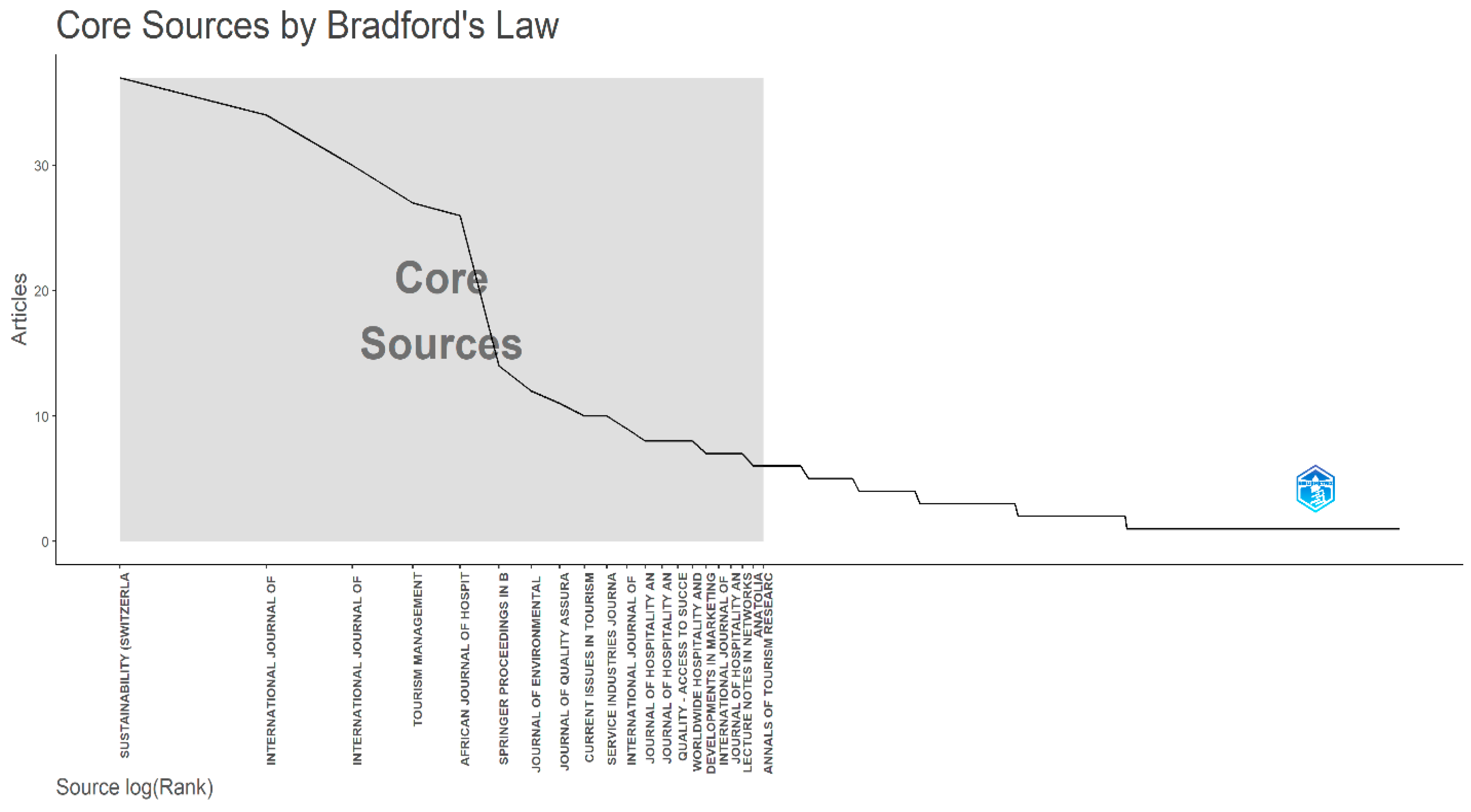
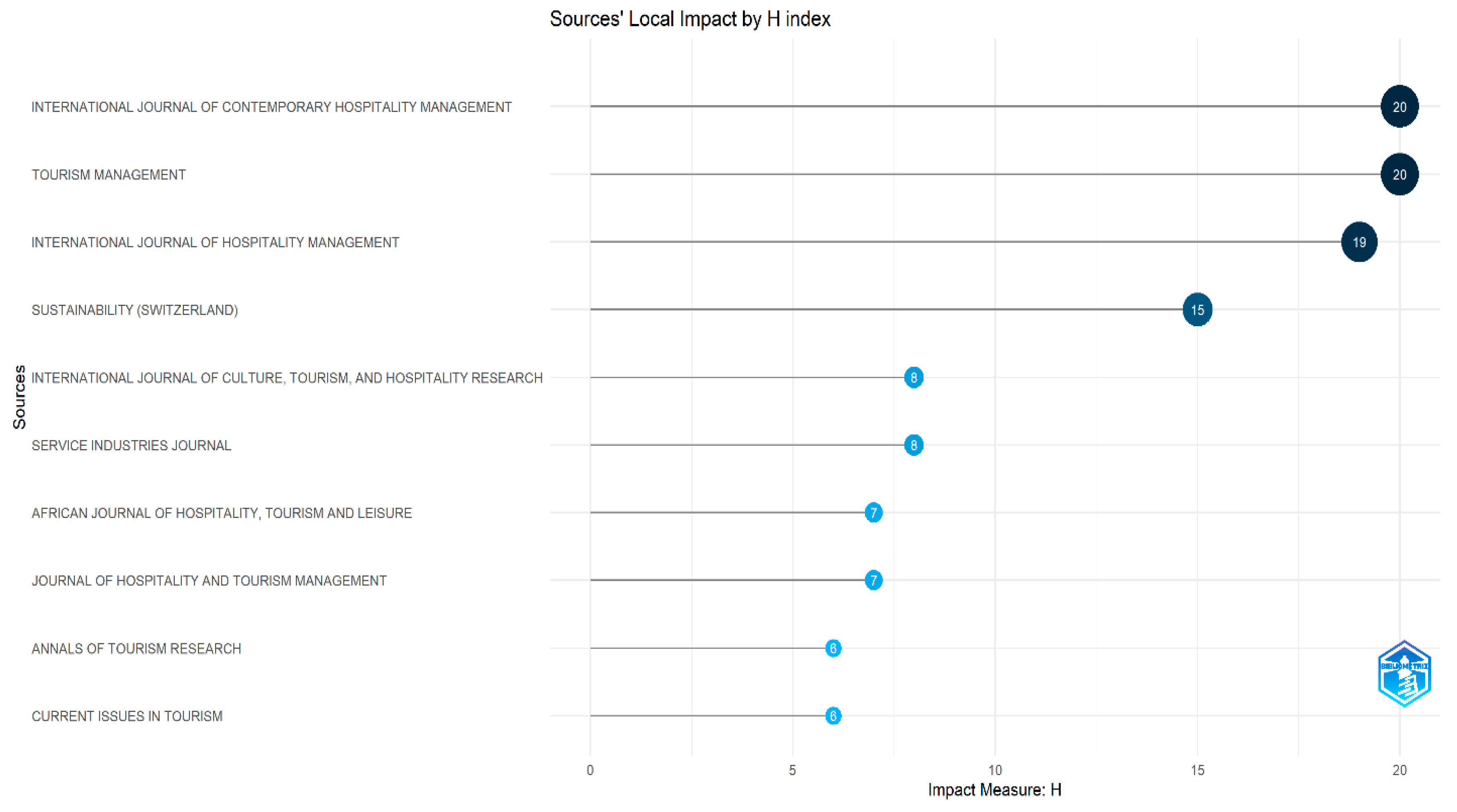

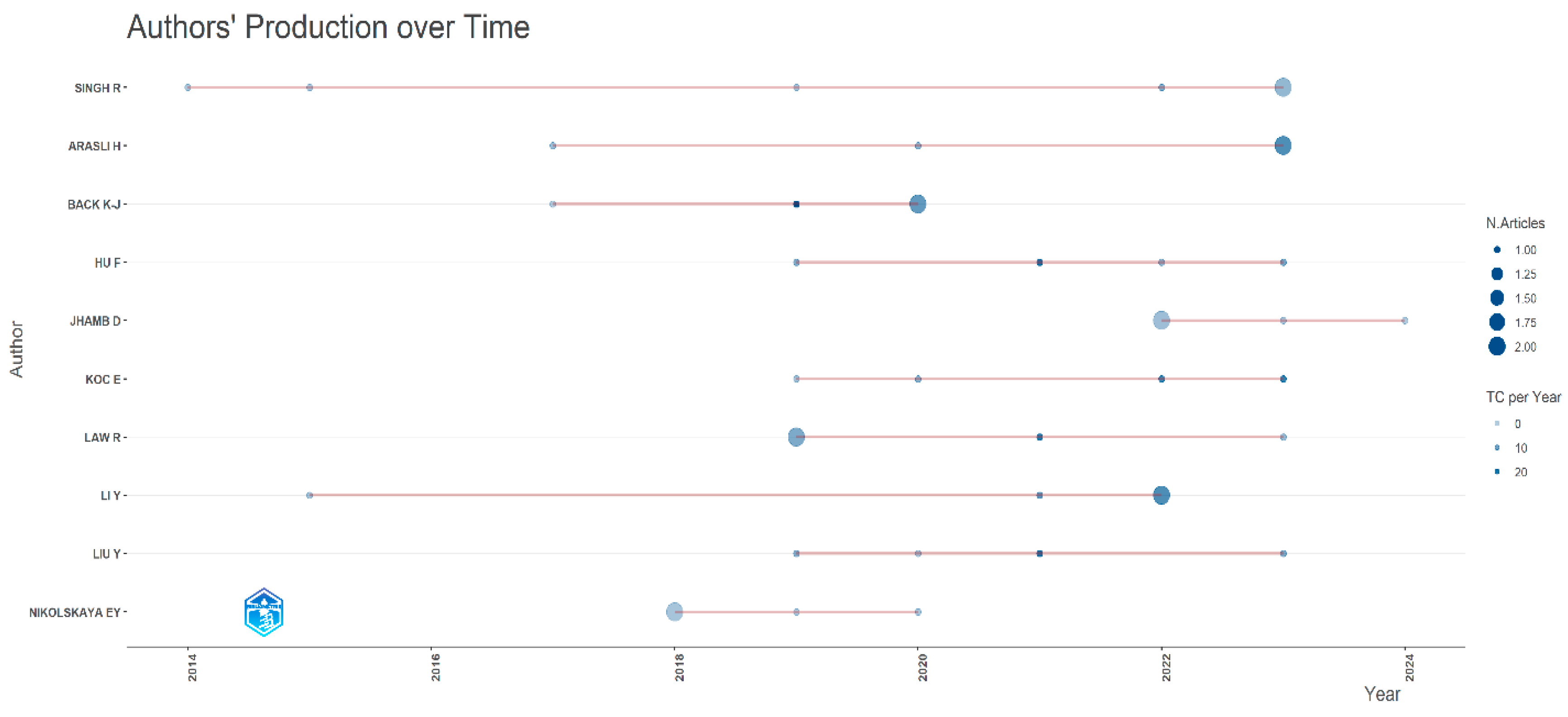
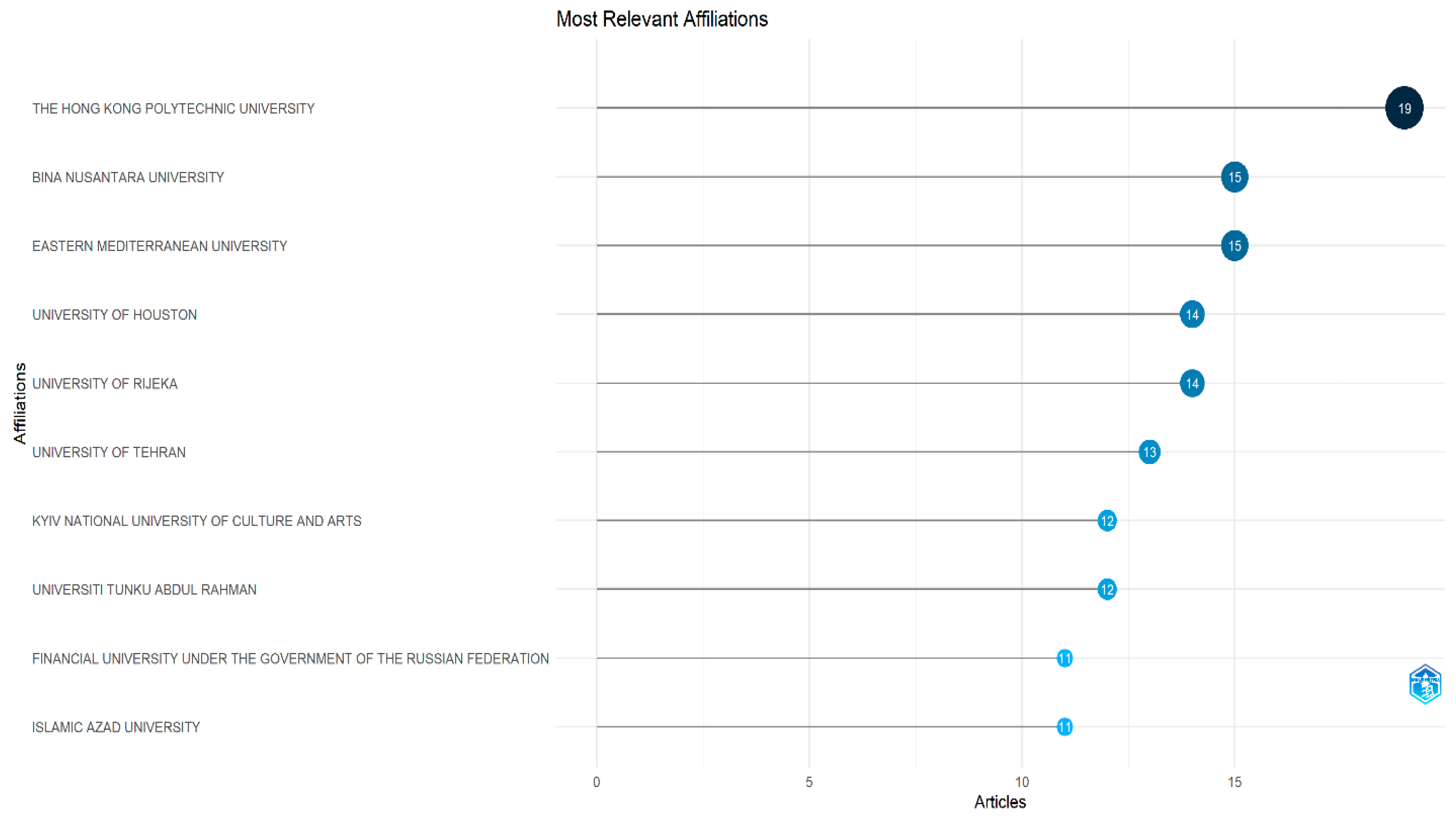
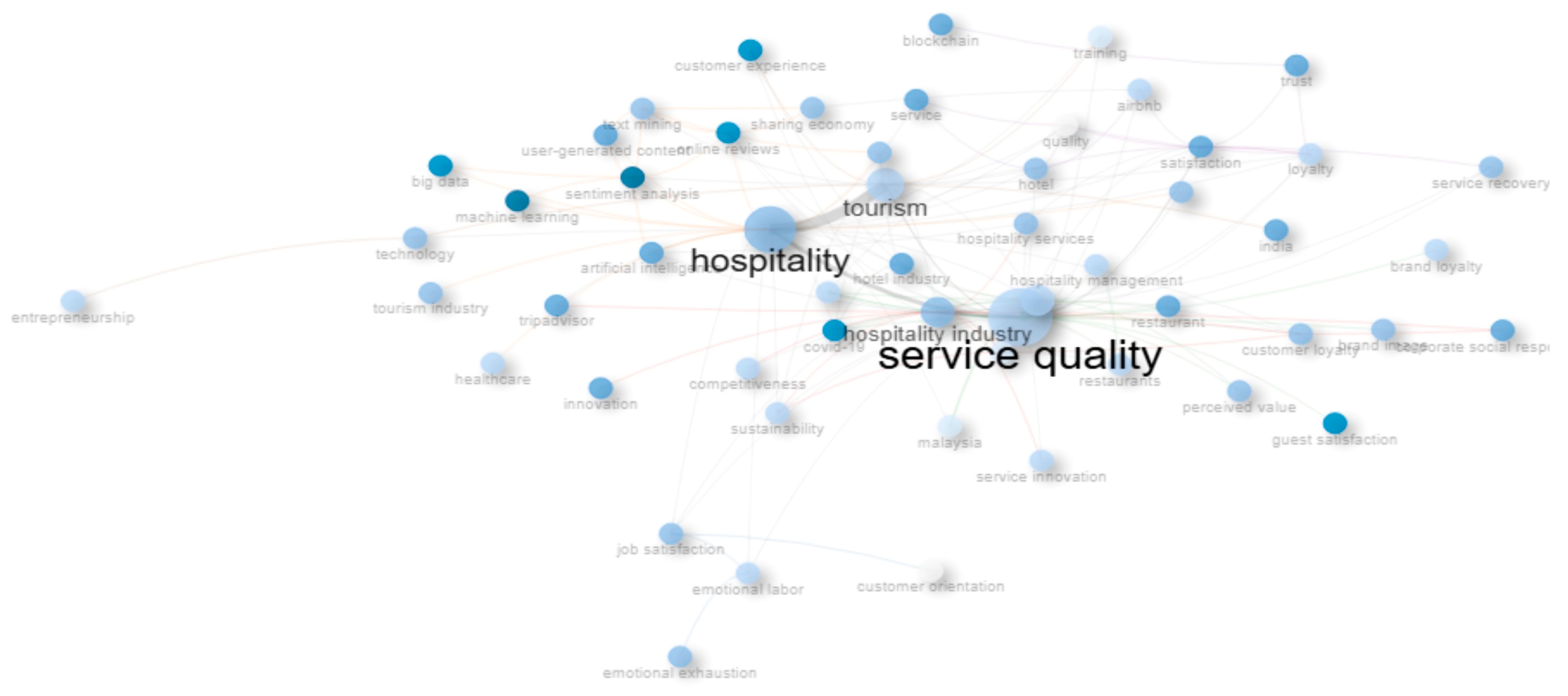
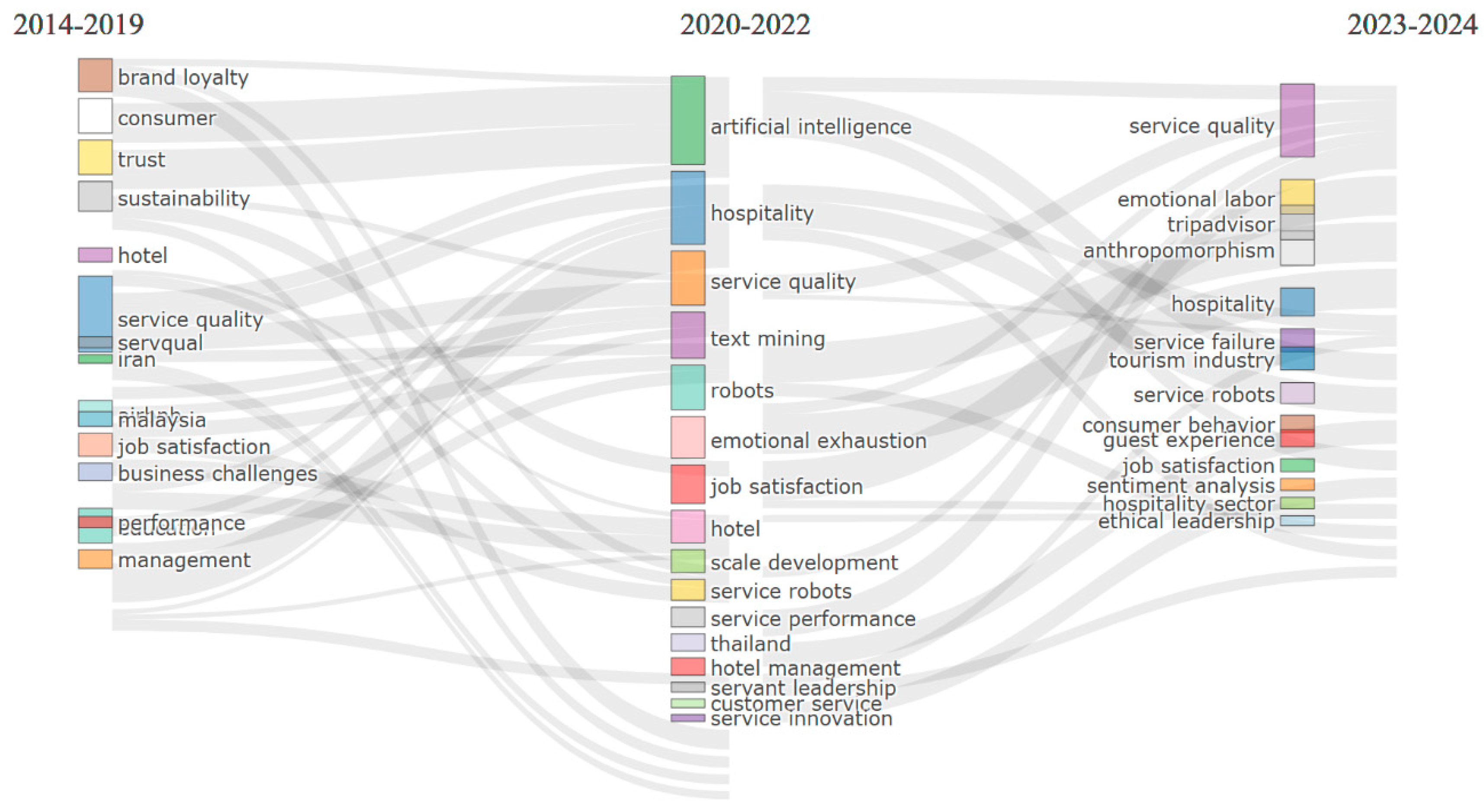
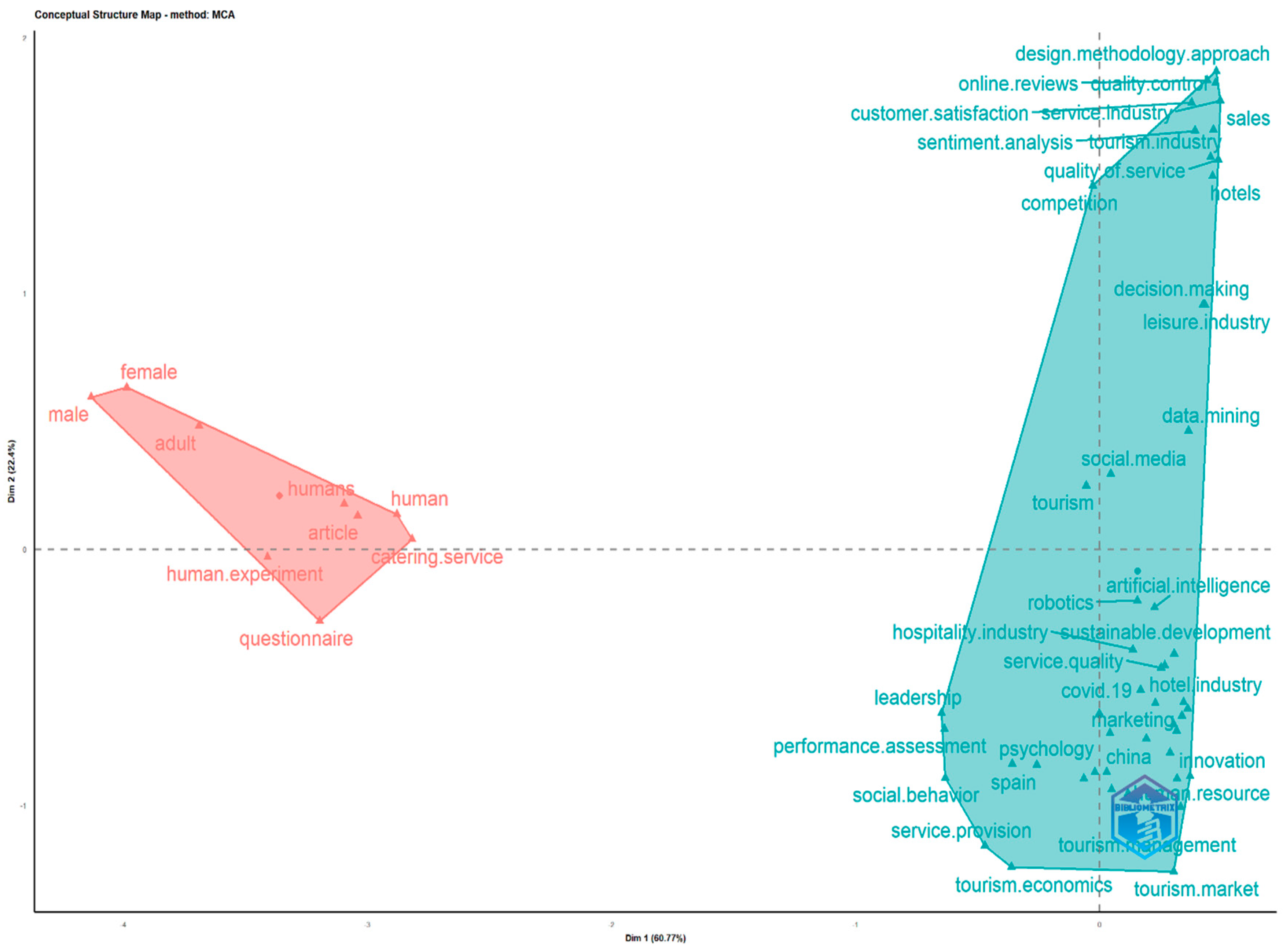
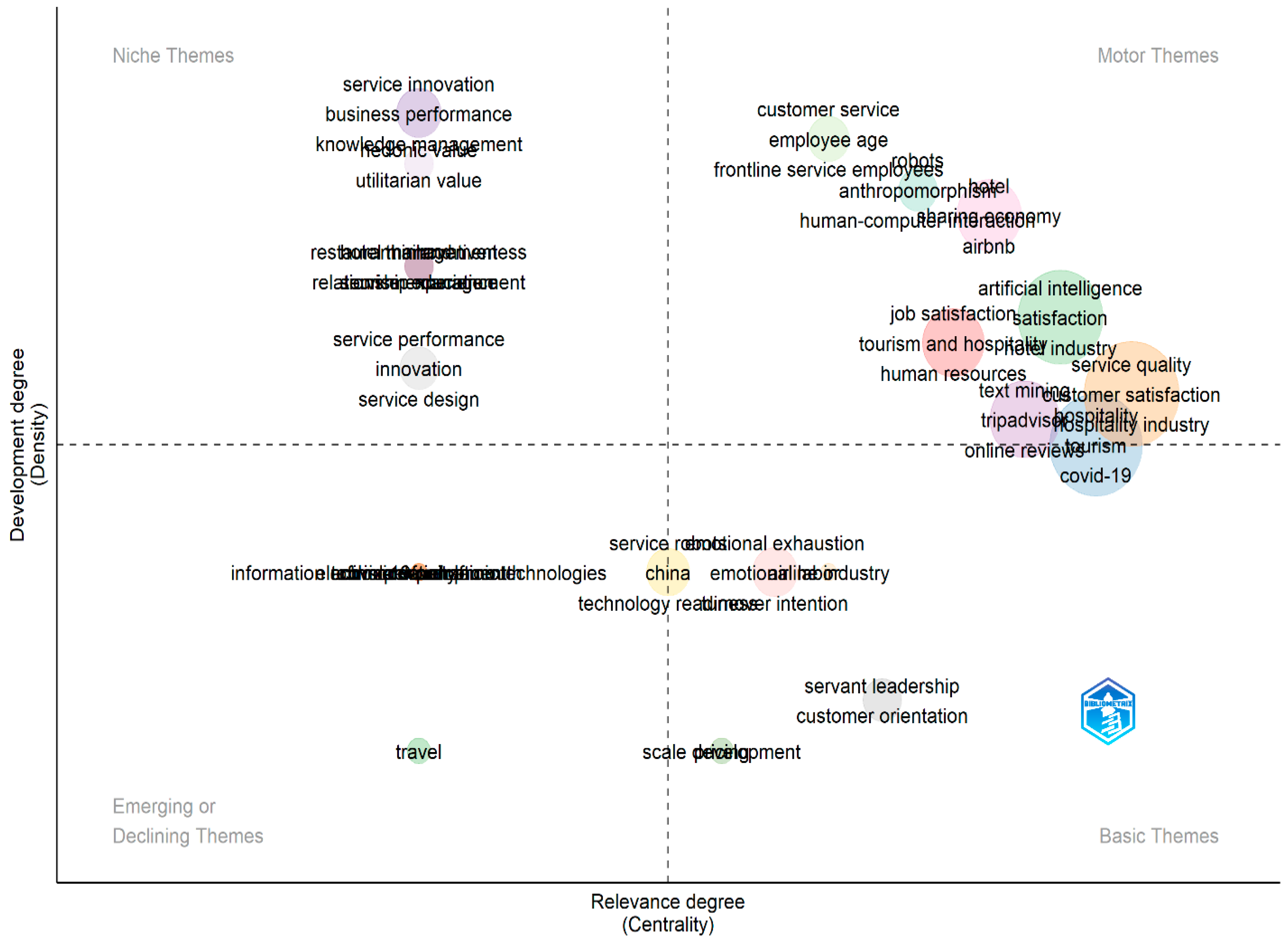
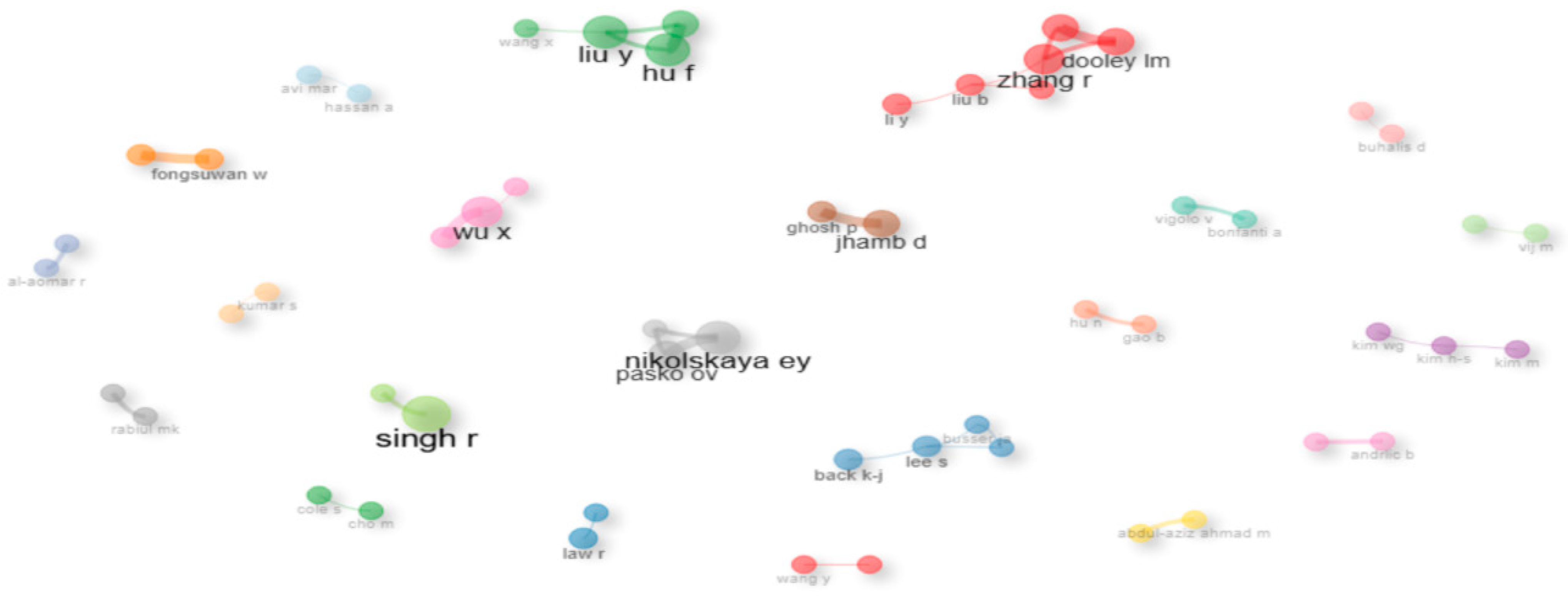

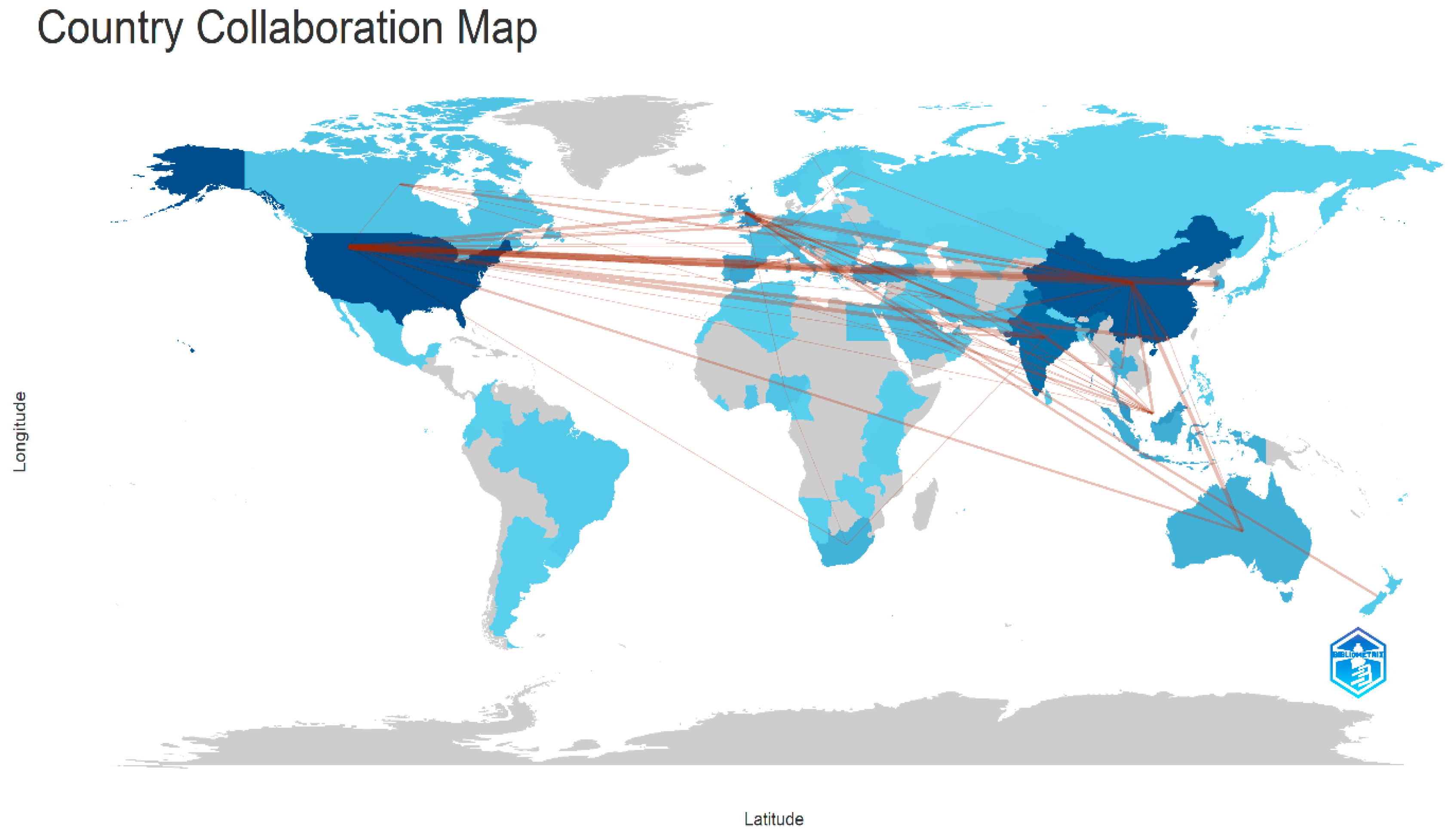

| S/N | Research Questions | Results | Examples of Key Publications |
|---|---|---|---|
| 1. | What was the citation overview of the publications in 2014–2024? | The citation overview of the articles revealed that the highest number of publications took place in 2024, with a total of 153 publications. The year 2021 had the highest figure of average citations per year (5.6). Prominent keywords in the articles were service quality, hospitality, satisfaction, artificial intelligence, and hotels. | Anas (2024), Asgeirsson et al. (2024), and Legendre et al. (2024) |
| 2. | What were the sources of the publications in 2014–2024? | The most relevant sources, in descending order, were Sustainability (Switzerland), with 37 published articles and the International Journal of Contemporary Hospitality, with 34 published articles. Sustainability (Switzerland) produced the highest number of articles on the hospitality industry. Bradford’s law revealed that the highest publication core source was Sustainability (Switzerland), with 37 publications. The International Journal of Contemporary Hospitality Management and Tourism Management both had more articles and the highest H-index of 20 each. | Pilelienė et al. (2024), Oliveras-Villanueva et al. (2020), and Sigala et al. (2021) |
| 3. | What was the information about the authors of the publications in 2014–2024? | The researcher Singh R. had the highest number of publications between 2014 and 2024, with a total of six publications accumulated in the years 2014, 2015, 2019, 2022, and 2023. Hong Kong Polytechnic University was the most relevant institution, with 19 published articles, followed by Bina Nusantara University, with 15 published articles, and Eastern Mediterranean University, with 15 published articles. | Shyju et al. (2021), Arasli et al. (2020), Hu et al. (2019), And Singh and Nika (2019) |
| 4. | What was the conceptual structure of the publications in 2014–2024? | Service quality and hospitality were words that featured very prominently in terms of co-occurrence. The keywords under the foundational and traditional themes were brand loyalty, consumer, trust, sustainability, hotel, service quality, and SERVQUAL. The keywords under the technology and pandemic impact themes were artificial intelligence, hospitality, service quality, text mining, robots, and job satisfaction. The keywords under the themes of refinement and post-pandemic adaptation were service quality, emotional labor, Tripadvisor, anthropomorphism, hospitality, and service failure. As regards the thematic quadrants, the motor themes were densely populated with keywords such as customer service and employee age. The niche themes were fairly well populated with specialized keywords such as service innovation and business performance. | Singh and Nika (2019), Oliveras-Villanueva et al. (2020), and Arasli et al. (2020). |
| 5. | What was the social structure of the publications in 2014–2024? | Researcher(s) in Cyprus had published jointly authored articles with researcher(s) in Greece, and researchers in Romania had jointly authored articles with researcher(s) in Poland. The keywords captured under high centrality were hospitality (conf 55.1%), tourism (66.7%), and hotel sector (85.7%). The cluster-by-authors coupling revealed that hospitality industry (71%), Tanzania (100%), and blockchain (57.1%) were high-impact and low-centrality keywords. | Santos et al. (2020), Pilelienė et al. (2024), Shyju et al. (2021), Perdomo-Verdecia et al. (2024), and others. |
Disclaimer/Publisher’s Note: The statements, opinions and data contained in all publications are solely those of the individual author(s) and contributor(s) and not of MDPI and/or the editor(s). MDPI and/or the editor(s) disclaim responsibility for any injury to people or property resulting from any ideas, methods, instructions or products referred to in the content. |
© 2025 by the authors. Licensee MDPI, Basel, Switzerland. This article is an open access article distributed under the terms and conditions of the Creative Commons Attribution (CC BY) license (https://creativecommons.org/licenses/by/4.0/).
Share and Cite
Olawuyi, O.S.; Kleynhans, C. A Bibliometric Analysis of Service Quality in the Hospitality Industry (2014–2024). Adm. Sci. 2025, 15, 215. https://doi.org/10.3390/admsci15060215
Olawuyi OS, Kleynhans C. A Bibliometric Analysis of Service Quality in the Hospitality Industry (2014–2024). Administrative Sciences. 2025; 15(6):215. https://doi.org/10.3390/admsci15060215
Chicago/Turabian StyleOlawuyi, Olakunle Shakur, and Carina Kleynhans. 2025. "A Bibliometric Analysis of Service Quality in the Hospitality Industry (2014–2024)" Administrative Sciences 15, no. 6: 215. https://doi.org/10.3390/admsci15060215
APA StyleOlawuyi, O. S., & Kleynhans, C. (2025). A Bibliometric Analysis of Service Quality in the Hospitality Industry (2014–2024). Administrative Sciences, 15(6), 215. https://doi.org/10.3390/admsci15060215





